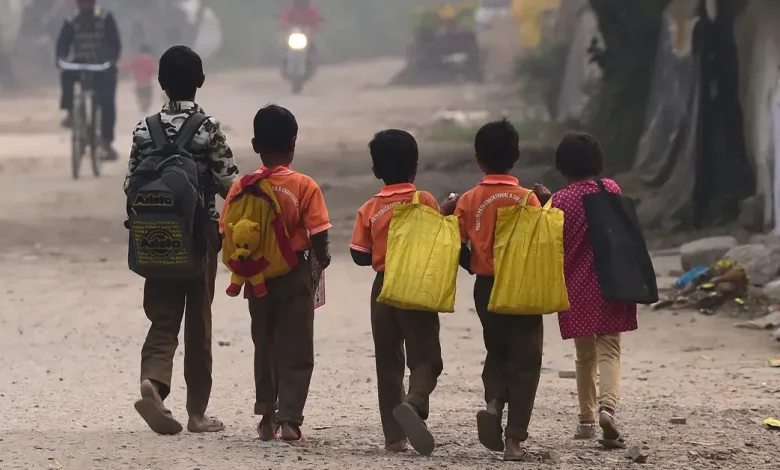
Context- Recently, the Union Finance Minister informed that about 25 crore people have been raised from multi-dimensional poverty in the last 10 years.
About
- It is a state or condition wherein someone or community lacks the economic sources and necessities for a minimum standard of living, including housing, easy water, healthful food, and medical attention.
- Traditionally, poverty is calculated based either on income levels or, if income data are not available, on expenditure levels.
- The ‘poverty lines’ are actually income levels which are considered minimum enough for someone to be called poor.
- A person who is poor can suffer more than one dangers like poor health or malnutrition, a loss of smooth water or electricity, poor working conditions or little education.
- Focusing on one aspect alone, including profits, is not sufficient to capture the genuine reality of poverty.
What is the Multidimensional Poverty Index (MPI)?
-
- Globally, the MPI uses 10 indicators masking 3 primary areas:
- Health includes nutrients and child & adolescent mortality indicators.
- Education consists of years of schooling and school attendance indicators.
- Standard of living consists of six household-specific indicators: housing, household assets, type of cooking fuel, access to sanitation, drinking water, and electricity.
- Globally, the MPI uses 10 indicators masking 3 primary areas:
- The Indian MPI has two additional indicators:
-
-
- Maternal Health (under the health measurement) and;
- Bank Accounts (under the standard of residing dimension).
-
- Multidimensional Poverty in India Since 2005-06:
-
- It is published by NITI Aayog with technical inputs from the United Nations Development Programme (UNDP) and the Oxford Policy and Human Development Initiative (OPHI).
- It uses indicators in three main areas: health, education, and standard of living.
- It is expected to decline from 29.17% in 2013-14 to 11.28% in 2022-23 with about 24.82 crore human beings escaping poverty at some stage in this period.
- At the States’ stage, Uttar Pradesh topped the listing with 5.94 crore human beings escaping poverty accompanied by Bihar at 3.77 crore and Madhya Pradesh at 2.30 crore.
- However, the largest number of poor people within the global — 228.9 million — lived in India in 2020.
Related Data
- The NFHS-five (2019-21): About 14.96% of India’s populace are multidimensionally poor as compared to 24.85% of the population that turned into multidimensionally poor based totally at the 2015-16 (NFHS-4).
- It suggests that nearly 135 million people escaped poverty for the duration of the five-year duration.
- A UNDP study highlighted that 415 million Indians got here out of multidimensional poverty inside the last 15 years.
- According to the IMF, the ‘extreme poverty’ was as below 1% in 2020 due to the Pradhan Mantri Garib Kalyan Ann Yojana (PMGKY).
Reason for Poverty in India
- Economic Slowdown and Policy Decisions: The financial system has been slowing for nine quarters previous to the outbreak of the novel covid19 pandemic.
- Unemployment had reached a 45 year high in 2017-18.
- Child Malnutrition: India’s negative score comes nearly completely from the kid stunting and wasting parameters.
- Almost 35% of Indian kids are stunted, and although this is an awful lot higher than the 54.2% rate of 2000, it’s miles nevertheless a number of the world’s worst.
- Almost 17.3% of Indian children under five are wasted, that is the highest prevalence of toddler wasting within the world.
- Pandemic Impact: The pandemic led to an ‘unexpected rise in poverty’.
- Over an 8 month period (March to October 2020), common incomes of the lowest 10% of households had been lower via Rs 15,700.
- Homelessness: Increasingly, a big range of men and women are being rendered homeless across the world.
- There are each herbal in addition to guy-made reasons which can be contributing to this crisis
Government Efforts
- Interventions via Policies/Schemes: The government has elevated the social protection net through schemes like Pradhan Mantri Suraksha Bima Yojana (Accident Insurance), Atal Pension Yojana (Unorganized Sector), and Pradhan Mantri Jeevan Jyoti Yojana (Life Insurance).
- The MUDRA Yojana has enabled about eight crore people to start new corporations.
- Rural Development: The Ministry of Rural Development has implemented various programs to grow livelihood opportunities, empower rural women, provide a social protection net, and enhance infrastructure in rural areas.
- The principal consciousness is on growing livelihood possibilities, empowering rural women, supplying a social safety net, skilling rural teens, infrastructure improvement, growing land productiveness, and so on.
- Nutrition and Health: Despite the development in monetary improvement, a considerable part of the Indian population cannot afford wholesome meals.
- Initiatives like Poshan Abhiyan and Anaemia Mukt Bharat were released to cope with this issue.
- State-Level Efforts: States like Uttar Pradesh, Bihar, and Madhya Pradesh have recorded the biggest decline inside the variety of multidimensionally negative humans.
Various Committees
- There are various committees fashioned with the objective to estimate the number of people living in poverty in India. These are:
- The Working Group of 1962;
- V N Dandekar and N Rath in 1971;
- Y K Alagh in 1979;
- D T Lakdawala in 1993;
- Suresh Tendulkar in 2009;
- C Rangarajan in 2014.
- The Lakdawala Committee assumed that health and training was provided by the country.
- Therefore, expenditure on those objects was excluded from the intake basket it proposed. Since expenditure on health and training rose substantially in the 99, the Tendulkar Committee covered them within the basket.
Source: Indian Express





.png)



